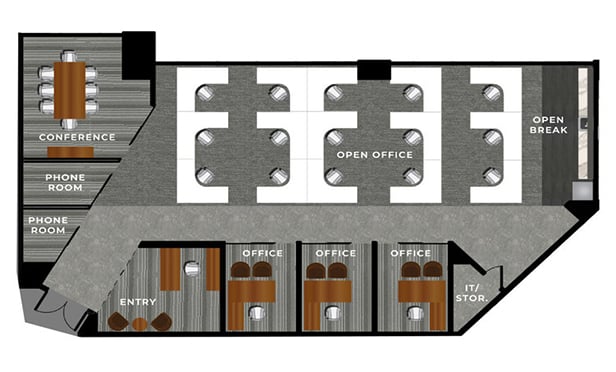
HOUSTON—Hurricanes, tropical storms and floods are not unexpected in Houston and the surrounding Texas Gulf region. More than eight major floods or hurricanes have impacted the Houston MSA since 1998. But when Hurricane Harvey struck the region near Rockport, TX on August 25, the Category 4 storm was the strongest to hit the region since 1961, dumping 10 inches of rain per day for five days, causing extensive property damage due to flooding.
Many key think tanks, research departments and urban planning groups have taken a look at the impact of the water to draw some conclusions. For example, the Urban Institute Housing Finance Policy Center offers four perspectives via mapping on how the recent flooding impacted the city.
Researchers Bhargavi Ganesh and Sarah Strochak have compiled four maps which show the distribution by zip code of Houston homeownership rates, incomes, home equity and the density of Federal Housing Administration loans. Maps of the recent flooding can be superimposed on each of the four underlying maps to see exactly how the flooding impacted these different zip codes.
The maps reveal several important things policy makers need to keep in mind as they prioritize recovery efforts, says the Urban Institute. Homeownership, which is strong in Houston, took a hard hit. Harvey hit all areas, all incomes and all property types, but most especially, minorities recovering from the housing bust were hit with a new blow. And, borrowers with FHA-insured government loans were heavily affected. Moreover, newer homeowners are in danger of slipping into negative equity.
The highest estimates of damage are 196,000 single-family homes, but the conservative number is 30,000 to 40,000 homes, GlobeSt.com learns. The majority of the residential properties affected by flooding were single-family homes in suburban areas to the northeast, west and southwest of downtown Houston, or in just three of the nine counties comprising the 700-square-mile Greater Houston market, according to CBRE.
More than 73,000 National Flood Insurance Program claims have already been submitted and $13.2 million in advance payments have been issued, GlobeSt.com learns. Displaced homeowners likely will lease class-A multifamily units and developers may look for sites to develop sooner than previously anticipated.
As many as 100,000 multifamily units (one out of six) were flooded, which means that any spot softness in the market is now gone. A small number of high-density submarkets sustained damage in as much as 30% of existing inventory, totaling approximately 22,300 occupied units and creating immediate leasing demand, says CBRE.
Apartments currently for rent that escaped the storm in west, northwest and northeast Houston will have sharp occupancy increases by the start of the third quarter. Concessions and competitive move-in specials characterizing the rental market since 2016 are expected to quickly rescind, and renters with leases expiring in the next six months should not anticipate any type of renewal incentives, CBRE predicts.
From a single-family residential perspective, land prices will be tested as increases for construction and labor rise. In addition, new development requirements for flood control and water drainage will likely be imposed on large single-family land tracts despite existing drainage requirements for new subdivisions, such as detention ponds, curbs, gutter drains and levees.
To help restore a healthy housing market in Houston, HUD must be engaged, flood insurance issues must be addressed, newer homeowners who have lost equity must receive special attention and efforts toward opening the credit box must continue. In addition, all parts of the housing finance ecosystem need to be engaged, responsive and learn from this effort, the Urban Institute concludes, based on its findings.

HOUSTON—Hurricanes, tropical storms and floods are not unexpected in Houston and the surrounding Texas Gulf region. More than eight major floods or hurricanes have impacted the Houston MSA since 1998. But when Hurricane Harvey struck the region near Rockport, TX on August 25, the Category 4 storm was the strongest to hit the region since 1961, dumping 10 inches of rain per day for five days, causing extensive property damage due to flooding.
Many key think tanks, research departments and urban planning groups have taken a look at the impact of the water to draw some conclusions. For example, the Urban Institute Housing Finance Policy Center offers four perspectives via mapping on how the recent flooding impacted the city.
Researchers Bhargavi Ganesh and Sarah Strochak have compiled four maps which show the distribution by zip code of Houston homeownership rates, incomes, home equity and the density of Federal Housing Administration loans. Maps of the recent flooding can be superimposed on each of the four underlying maps to see exactly how the flooding impacted these different zip codes.
The maps reveal several important things policy makers need to keep in mind as they prioritize recovery efforts, says the Urban Institute. Homeownership, which is strong in Houston, took a hard hit. Harvey hit all areas, all incomes and all property types, but most especially, minorities recovering from the housing bust were hit with a new blow. And, borrowers with FHA-insured government loans were heavily affected. Moreover, newer homeowners are in danger of slipping into negative equity.
The highest estimates of damage are 196,000 single-family homes, but the conservative number is 30,000 to 40,000 homes, GlobeSt.com learns. The majority of the residential properties affected by flooding were single-family homes in suburban areas to the northeast, west and southwest of downtown Houston, or in just three of the nine counties comprising the 700-square-mile Greater Houston market, according to CBRE.
More than 73,000 National Flood Insurance Program claims have already been submitted and $13.2 million in advance payments have been issued, GlobeSt.com learns. Displaced homeowners likely will lease class-A multifamily units and developers may look for sites to develop sooner than previously anticipated.
As many as 100,000 multifamily units (one out of six) were flooded, which means that any spot softness in the market is now gone. A small number of high-density submarkets sustained damage in as much as 30% of existing inventory, totaling approximately 22,300 occupied units and creating immediate leasing demand, says CBRE.
Apartments currently for rent that escaped the storm in west, northwest and northeast Houston will have sharp occupancy increases by the start of the third quarter. Concessions and competitive move-in specials characterizing the rental market since 2016 are expected to quickly rescind, and renters with leases expiring in the next six months should not anticipate any type of renewal incentives, CBRE predicts.
From a single-family residential perspective, land prices will be tested as increases for construction and labor rise. In addition, new development requirements for flood control and water drainage will likely be imposed on large single-family land tracts despite existing drainage requirements for new subdivisions, such as detention ponds, curbs, gutter drains and levees.
To help restore a healthy housing market in Houston, HUD must be engaged, flood insurance issues must be addressed, newer homeowners who have lost equity must receive special attention and efforts toward opening the credit box must continue. In addition, all parts of the housing finance ecosystem need to be engaged, responsive and learn from this effort, the Urban Institute concludes, based on its findings.
Want to continue reading?
Become a Free ALM Digital Reader.
Once you are an ALM Digital Member, you’ll receive:
- Breaking commercial real estate news and analysis, on-site and via our newsletters and custom alerts
- Educational webcasts, white papers, and ebooks from industry thought leaders
- Critical coverage of the property casualty insurance and financial advisory markets on our other ALM sites, PropertyCasualty360 and ThinkAdvisor
Already have an account? Sign In Now
*May exclude premium content© 2025 ALM Global, LLC, All Rights Reserved. Request academic re-use from www.copyright.com. All other uses, submit a request to [email protected]. For more information visit Asset & Logo Licensing.








